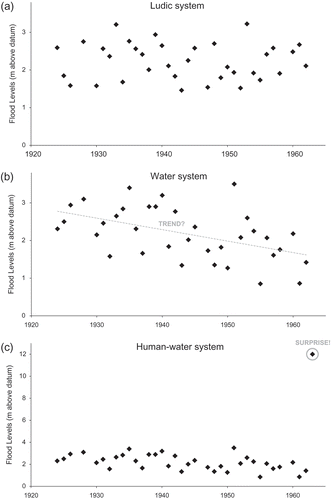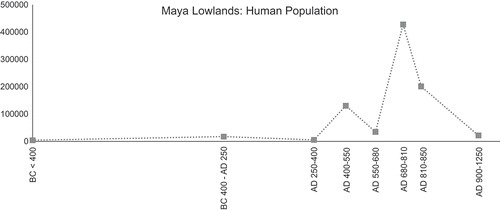Figures & data
Figure 1. The socio-hydrological cycle. Societies change the hydrological regime via human activities (urbanization, deforestation) and interventions (e.g. dams, levees) while the experience of hydrological changes shapes societies. Human and water systems are deeply intertwined and respond to regional changes in climate, economy, technology and culture.

Figure 2. Examples of time series of ludic (a), water (b) and human–water (c) systems. (a) Synthetic time series of flood levels, randomly generated using the mean and variance of the annual maximum water levels recorded on the Piave River at Ponte delle Alpi, Italy. (b) The actual time series of annual maximum water levels. (c) The entire time series of annual maximum water levels, which includes the surprisingly high (and essentially unpredictable) water level of 9 October 1963. From (a) to (c), the seventh facet of uncertainty plays an increasingly major role.

Figure 3. Example of simulating flood risk changes. Current approaches can provide satisfactory results in simulating the reduction of risk immediately after the implementation of structural measures, e.g. decreased probability of flooding due to levee heightening. However, they are unable to capture future changes as they neglect the societal feedback to hydrological change. The diagram shows an example where the actual risk is much higher than the simulated one and well beyond uncertainty bounds, which were computed treating uncertainty as if aleatory. This example reflects the dynamics of risk observed in many real-world cases (e.g. Kates et al. Citation2006, Bohensky and Leitch Citation2014, Di Baldassarre et al. Citation2015), whereby the reduced probability of flooding has triggered unexpected increases of population and economic activities in flood-prone areas (levee paradox; White Citation1945).

Figure 4. Human population history in the Maya Lowlands. The diagram shows demographic growth periods and collapses, plausibly due to hydrological extremes, i.e. persistent drought conditions (Gill et al. Citation2007).

